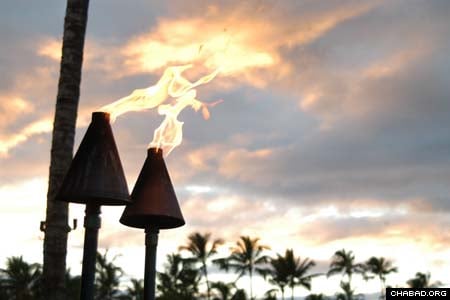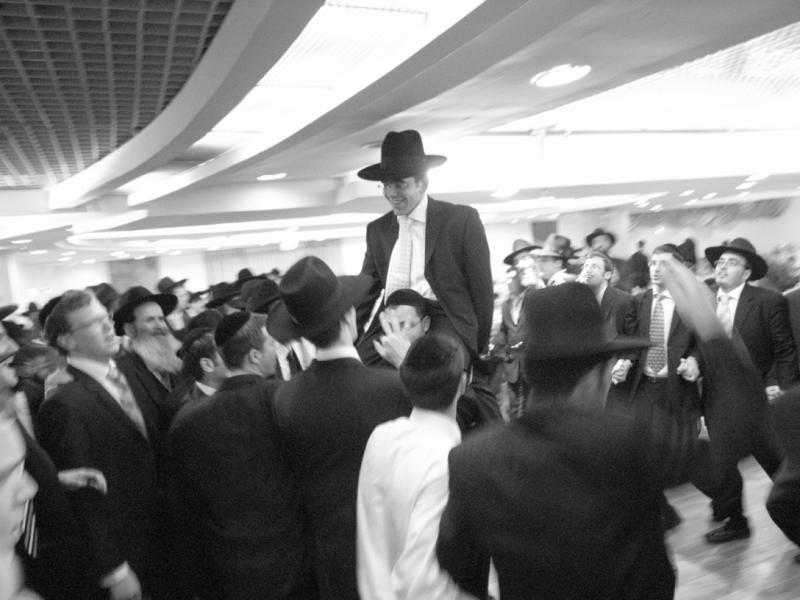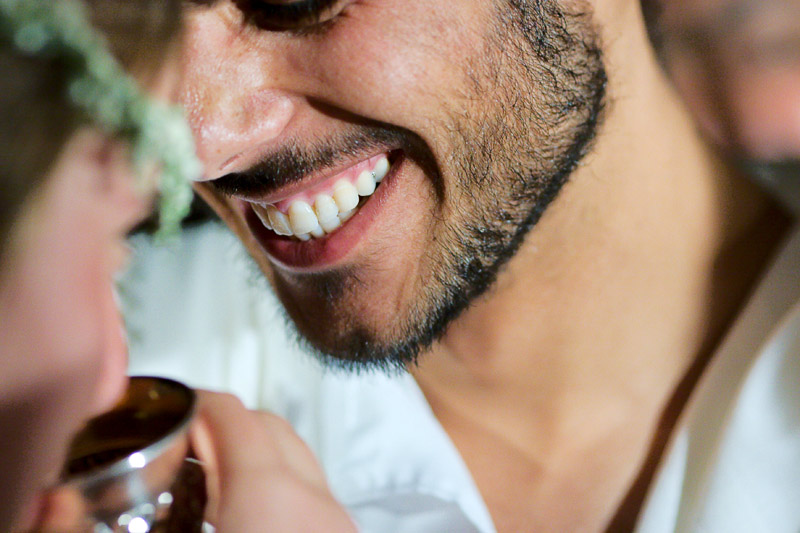
(From Chabad.org)
An unforgettable wedding for the local Jewish community, plus hundreds of guests from around the world, took place this week in Hawaii. In a first for the island state, the Chasidic wedding of Rivky Krasnjansky – daughter of Chabad-Lubavitch of Hawaii co-directors Rabbi Itchel and Pearl Krasnjansky – and Rabbi Avremel Chazanow of New Jersey paired ancient Jewish traditions with tropical flair. Food was flown-in from the mainland while the Krasnjanskys took over a resort hotel’s kitchen.
 More than 500 guests helped escort the bride and groom, viewed by Jewish tradition as a king and queen on the day of their wedding.
More than 500 guests helped escort the bride and groom, viewed by Jewish tradition as a king and queen on the day of their wedding.
From the Hawaii Star Bulletin
by Mary Adamski
Couple unites under strict Jewish tenets
Rivky Krasnjansky of Honolulu and Avremel Chazanow of Brooklyn, N.Y., believe that God will be a third partner in their marriage.
Their Wednesday wedding will be an affirmation of faith for the pair, members of the Chabad Lubavitch movement of Orthodox Judaism, which teaches strict adherence to laws laid out more than 3,000 years ago.
For Rivky and Avremel, both 20, being true to that law has meant a courtship with no physical contact, not even a chaste kiss, she said. They're now in a seven-day "no talk" zone, not allowed to compare notes or share the anticipation until they are escorted to stand under a ceremonial canopy called a "chupah." In the old days families could keep their kids sequestered, but in these days of computer and cell phone, that's quite a discipline.
For the parents it's the usual whirlwind of shopping and planning, the logistics of accommodating guests arriving from several countries, topped off by the element of ensuring religious correctness. But who's complaining?
Rabbi Itchel Krasnjansky and his wife, Pearl, who established the Honolulu branch of Chabad 20 years ago, are over the top with excitement at presenting a "full-on Orthodox wedding" for their daughter. They think it might be the first Chasidic wedding in Hawaii.
Chasidic refers to the strict observance of the law in the Torah, which Christians know as the first five books of the Old Testament. The extent to which people observe the requirements for diet, conduct, hygiene as well as religious practice differ in the various branches of Judaism.
Because of the law, the mother of the bride had to buy 500 plates for the wedding banquet because the dinnerware at Ihilani Resort at Ko Olina is not considered kosher. The hotel kitchen is not kosher, so a side kitchen will be set up. Student rabbis will use a blowtorch on the ovens and extreme ritual cleaning to render the kitchen clear of impurities.
"It's a challenge in Hawaii; we don't have the infrastructure we would elsewhere," said the rabbi. Kosher wines, and hundreds of pounds of kosher meats and other food were ordered from mainland suppliers not only for the Wednesday banquet, but to meet the requirement of feeding guests for seven nights.
The hour-long ceremony is loaded with scriptural symbolism.
Guests will arrive to find bride and groom sitting in ornate chairs like thrones, and they'll be free to schmooze with them. But only men may approach him, and she will only talk to the women. When they take their seats, the crowd will be segregated, women and men in separate sections, and that will continue through the banquet and the dancing.
Rivky Krasnjansky said friends will bring special prayer requests to her -- requests already came at a bridal shower this week -- and she will pray for them during the ceremony under the chupah.
Rabbi Itchel Krasnjansky of Chabad of Hawaii and his wife, Pearl, are planning a traditional Jewish wedding for daughter Rivky and her groom, Avremel Chazanow, on Wednesday. |
|
Avremel Chazanow is memorizing a revered rabbi's discourse on marriage which he will proclaim to the male visitors -- and the women, if they can hear it from their side of the room.
When they finally meet face to face under the canopy, one of the first things he will do is to cover her face with a thick veil.
"The veiling goes back to the story of Jacob, who was fooled into marrying Leah, who was brought to him veiled," said Rabbi Krasnjansky. "So it's important that he sees her face."
The veil is symbolic of the virtues of modesty and chastity. Speaking of modesty, the bridal gown is high-necked and long-sleeved according to tradition.
The groom will wear a white robe, called a "kittel," usually worn on Yom Kippur, the solemn Day of Atonement. It is symbolic of purity and holiness.
The canopy is open on four sides "based on the first Jewish person, Abraham, who opened his home to travelers and had doors on all sides to welcome people from all directions," said the rabbi.
"It's as old as Judaism itself," he said. The wedding is held outside -- lots of prayers about weather going on this week -- reflecting God's promise to Abraham that his descendants would be as numerous as the stars.
"The time under the chupah is a special spiritual moment," said the rabbi. The pair will pray quietly, then the ceremony led by Rabbi Shlomo Segal of Brooklyn, head of the Chabad International rabbinical court, will proceed with a reading of the marriage contract.
"Biblically, a legal contract must be solidified with something of value," said the mother of the bride.
Giving an unadorned band to the bride is in the requirements; a flashier engagement ring presented at the same time is optional.
There's no writing your own poetic marriage vows in this tradition. The contract text is more than 1,000 years old. It contains language that assures that the woman will be provided for with dignity, which Pearl Krasnjansky points out was an enlightened view for a historical time when women in other cultures were treated like possessions.
The number seven is significant in Jewish traditions, rooted in the story of creation in which God rested on the seventh day. In the wedding, the bride will circle the canopy seven times. Guest speakers will recite seven blessings, acknowledging God for creating mankind, the bride and groom and joy, and expressing hope that they grow in their love.
The ceremony ends with the groom stomping on a wineglass, crushing it, a symbol of the destruction of the temple in Jerusalem more than 2,000 years ago. "Even though this is a joyous moment, the joy is not complete because the temple has been destroyed and will not be complete until the temple is rebuilt and the Messiah comes," said the rabbi.
"When I think about the ceremony under the chupah, I get the feeling that God is there, how awesome it is," said Rivky Krasnjansky.
She met Chazanow when he came here as a student rabbi last year. He returned to New York, where he has another year of rabbinical school. They were reunited when she spent the summer in New York, and got engaged in August. They will return there, but first they have to stick around for the seven days of feasting with guests.
The groom is the son of Rabbi Baruch Chazanow of the Chabad branch in Manalapan, N.J., and his wife, Tova.
"It's important to marry someone with the same goals and values, who feels the same way about raising a family," she said. "Not only is he Jewish, but from the same group that I grew up in. We both want to do community and outreach work, and I hope we will come back to Hawaii someday."
Rabbi Krasnjansky said: "The third partner in a marriage is God. He is the foundation between the bride and the groom. With God as part of one's life, it is the foundation of a person's identity. In that way, God is an intimate partner.
"In our world view, it is a joy for all of the house of Israel when another home has been created. In Jewish tradition we are all one family."








 Felicity Carter
Felicity Carter




